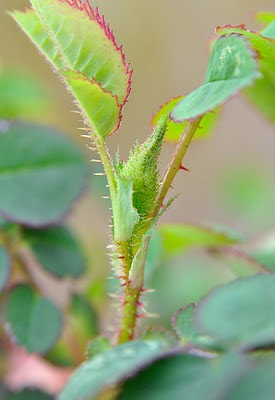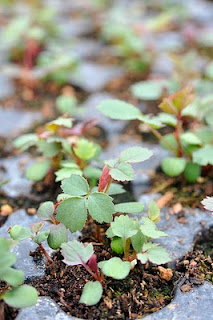
54-08-03 = 'Midnight Blue' X ('Orangeade' X R. fedtschenkoana). The latter is a Kim Rupert hybrid given to me years ago for breeding purposes. See:
LINK.
Some of you probably know that
R. fedtschenkoana was identified about a decade ago as one of the species that helped found the Damask class. Since then, some hybridizers like Kim Rupert have incorporated the species into their breeding program in order to explore its genes as a potential source of new characteristics. Kim gave me a piece of his 'Orangeade' X
R. fedtschenkoana hybrids several years ago and I have only recently started using it in my work. It took several years to start to flower, and because it clearly isn't ideally suited to my climate, it blooms only sparingly during its first cycle. And so, I rarely have pollen available at the right time.
However, in 2007 I managed to pollinate a few late blooms of 'Midnight Blue' with its pollen and about 14 seedlings resulted. Several of these grew so fast that they had to be moved into 5 gallon cans by June! I can see that hybrid vigor is something Kim's hybrid can bring into the mix. As expected, none of these flowered in their first year, and although "Kim's Fedtschenkoana" does rebloom, I don't expect my seedlings to be remontant. Often the remontancy genes from one class don't "play nice" with remontancy genes from another and what you get are mostly once bloomers. We shall see. To be honest, I don't expect anything but pinks, but with 'Orangeade' and 'Midnight Blue' in the mix, anything is possible.
The foliage is particularly attractive on these seedlings, most of them open with reddish tints and mature to a matte blue-green hue. The canes are matte as well, in brown and grey tones and fairly well armed with straight prickles. This year I will get them moved outdoors and see how they handle the typical diseases. (Kim's hybrid doesn't get any of the "big three" diseases, and with any luck, that might carry through to these seedlings)
The more I work with breeding roses, the more I find myself exploring non-traditional territory, often involving species and near-species hybrids. I think that if anything truly original and new is to be done with roses, it will surely come from the experimental breeding work of the dedicated "amateurs". (My friends, you know who you are!) The temptation to make crosses that will yield quick results is always there, but I say RESIST that temptation, and dare to strike your own trail. You just might end up creating a building block that future hybridizers might find invaluable in leading their own work forward. What better legacy could you want?!
 Busy day, potting up assorted seedlings of all kinds....
Busy day, potting up assorted seedlings of all kinds....







